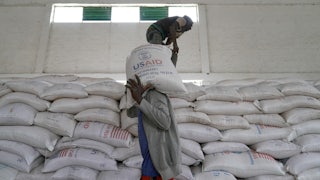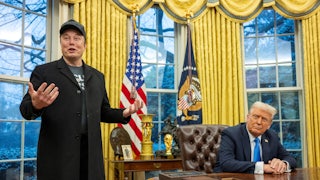You may have heard that Taylor Swift is going out on tour this spring for the first time in five years. When tickets for Swift’s “Eras Tour” went on sale Tuesday, computer glitches tied up Swift fans for hours, and some of these Swifties ended up having to pay more than $22,000 per ticket.
Representative Alexandria Ocasio-Cortez had no difficulty assigning blame. “Daily reminder,” she tweeted, “that Ticketmaster is a monopoly, [its] merger with LiveNation should never have been approved, and they need to be [reined] in.” Senator Amy Klobuchar fired off a letter to Live Nation president and chief executive Michael Raino “to express serious concerns about the state of competition in the ticketing industry.” Late Thursday, Ticketmaster canceled plans to sell additional tickets for the tour on Friday.
Ocasio-Cortez and Klobuchar weren’t wrong to flag antitrust concerns about Ticketmaster. There’s ample evidence that the 2010 merger enabled Live Nation Entertainment, a huge concert promoter, to muscle concert venues into using Ticketmaster as a condition of booking popular acts, in defiance of a previous district court ruling. In addition, Ticketmaster, like banks and airlines, has been piling on all sorts of “junk fees” that can add up to as much as 78 percent of sticker price, a practice that President Joe Biden last month directed the Consumer Financial Protection Bureau to curb. The Obama administration never should have permitted Live Nation and Ticketmaster to merge in the first place.
Still, none of this has much to do with torment Taylor Swift fans endured Tuesday, or the torment inflicted previously on fans of Harry Styles and Bruce Springsteen. The real blame resides with Swift (and Styles, and—it pains me to say as a lifelong Springsteen fan—the Boss).
Granted, if Ticketmaster had to compete more against rival ticketing companies, then perhaps its software would have been less kludgy when the Swifties came calling. But consider the extraordinary level of demand. On Tuesday, Ticketmaster sold more than two million Taylor Swift tickets. That’s more than any previous act—Enrico Caruso, Rudy Vallee, Frank Sinatra, The Beatles, Michael Jackson—ever sold in a single day. Whatever problems arose had their origin in Swift’s unprecedented popularity. Managing a high-class problem like that was ultimately the responsibility of the party who generated that demand in the first place, and that wasn’t Ticketmaster.
Swift was no bystander to Tuesday’s meltdown. Like a growing number of popular entertainers and businesses, she and her representatives chose in advance to address what she knew would be huge demand through dynamic pricing. Associated before now mainly with airline tickets, hotel rooms, and Uber rides, dynamic pricing is a mechanism where the cost of something rises or falls within a short time span according to demand. Dynamic pricing usually works fairly well, but when supply and demand get seriously out of whack, things can go haywire.
Tuesday’s Taylor Swift sale was for a reserved segment of available concert seats sold in advance of other seats through Ticketmaster’s dynamic pricing system. Ticketmaster wasn’t the first to apply dynamic pricing to live performances: Broadway theaters have for decades been selling high-priced premium seats way up front in the orchestra. And according to Ticketmaster, the company never sells seats in this manner without explicit consent from the performing artist. If this person doesn’t want Ticketmaster to sell premium seats, Ticketmaster doesn’t do so.
If the performer consents to dynamic pricing, then (again, according to Ticketmaster) this isn’t a simple yes-or-no proposition. The performer negotiates, through a representative, how many seats will be priced dynamically and what Ticketmaster will charge for them. “Promoters and artist representatives set pricing strategy and price range parameters on all tickets,” according to Ticketmaster, “including fixed and market-based price points,” i.e., regular seats and advance-sale premium seats. The performer’s representative also negotiates how the proceeds will be divided among Ticketmaster, the concert venue, and the performer. Ticketmaster’s near-monopoly status almost certainly gives it more leverage to take a bigger cut than would otherwise be the case, but that’s not the ticket buyer’s problem; it’s the venue’s problem—and Swift’s problem.
Ticketmaster didn’t sell anybody a $22,000 ticket to see Swift. The dynamically priced tickets were sold within a preset range of $49 to $499 (plus fees). The $22,000 tickets were spotted on Stub Hub, a scalping site. Ticket scalping is the resale of tickets for a higher price. State and local governments try periodically to outlaw or limit scalping, but there isn’t a lot you can do. If Person A wants to sell and Person B wants to buy, they will probably find a way.
People like Taylor Swift and Harry Styles and Bruce Springsteen, when they agree to dynamic pricing, typically do so reasoning that if their popularity has created high demand, then some of the resulting windfall ought to be diverted from scalpers to the artists themselves. It’s hard to begrudge them this. Who would you rather pay to attend the Eras Tour, StubHub or Taylor Swift? And by setting a price ceiling on premium seats, Swift can limit the extent to which ticket buyers get milked. There’s a big difference between $499 and $22,000. (A more dubious practice identified by John Oliver in a recent segment of Last Week Tonight is for a performer to scalp tickets held by the venue for the performer. Justin Bieber and Metallica have done this, Oliver said, citing news reports.)
We’ve started in recent years to see creative strategies to address out-of-control demand for live performances. Lin-Manuel Miranda experimented with all sorts of ways to make his monster Broadway hit Hamilton accessible to nonwealthy people, especially schoolkids, and ultimately he (or more likely, the producers) arranged for the original cast to record a performance for broadcast in movie theaters or television. (In the end, Disney streamed it on TV.) Springsteen did the same (via Netflix) with his hugely popular show Springsteen on Broadway. New York’s Metropolitan Opera, Britain’s National Theater, and various other arts organizations have been streaming content to movie theaters and TV screens for years. The technology is superb and, aesthetically, I don’t recognize an enormous difference, other than bragging rights, between being there and not. (Front row center? Yes, I’d see a difference then. But who can afford that?)
The next step should be to stream rock and pop concerts in real time, or close to it. That ought to help avoid digital stampedes for tickets like the one Swifties suffered on Tuesday. A Swiftie might answer that nothing compares to seeing Taylor Swift in person. But how “in person” is that, really? If the concert’s in a huge arena, you’ll probably be looking at a Jumbotron (and you’ll definitely be listening to amplified music). You might as well watch in a movie theater with a bag of buttered popcorn, or on the couch at home.
I don’t know why streaming hasn’t caught on with pop culture to the same extent that it has with highbrow content like La Traviata. Yes, streaming would reduce what you could charge to witness Taylor Swift in person. That’s the point! Ticketmaster would hate it. But revenue from streaming would compensate the performer’s losses and then some. Most important, pop music would be re-democratized, as it’s very much meant to be.










